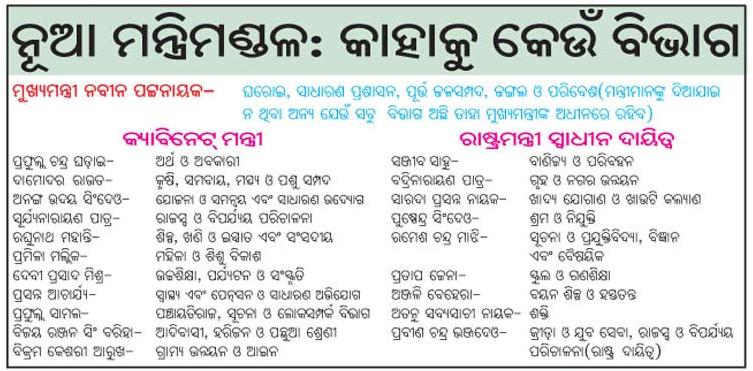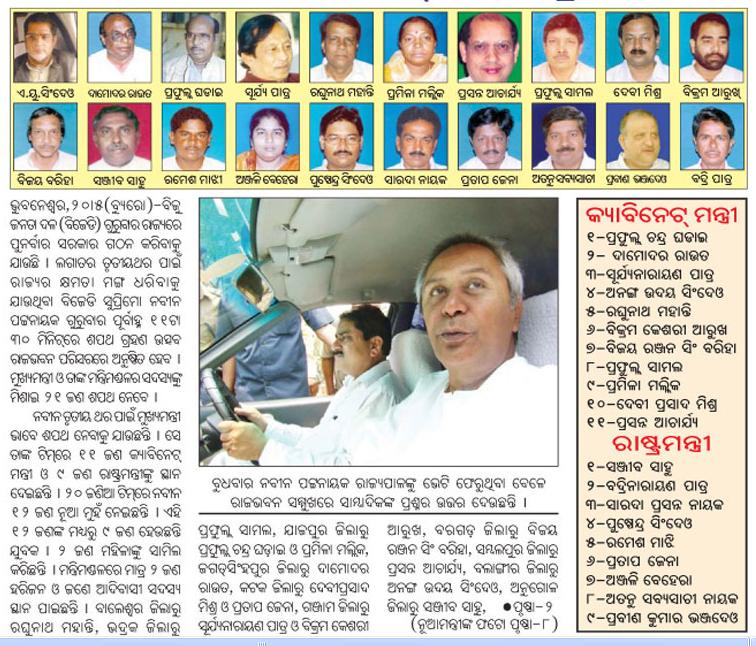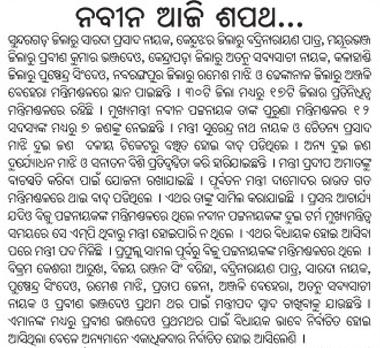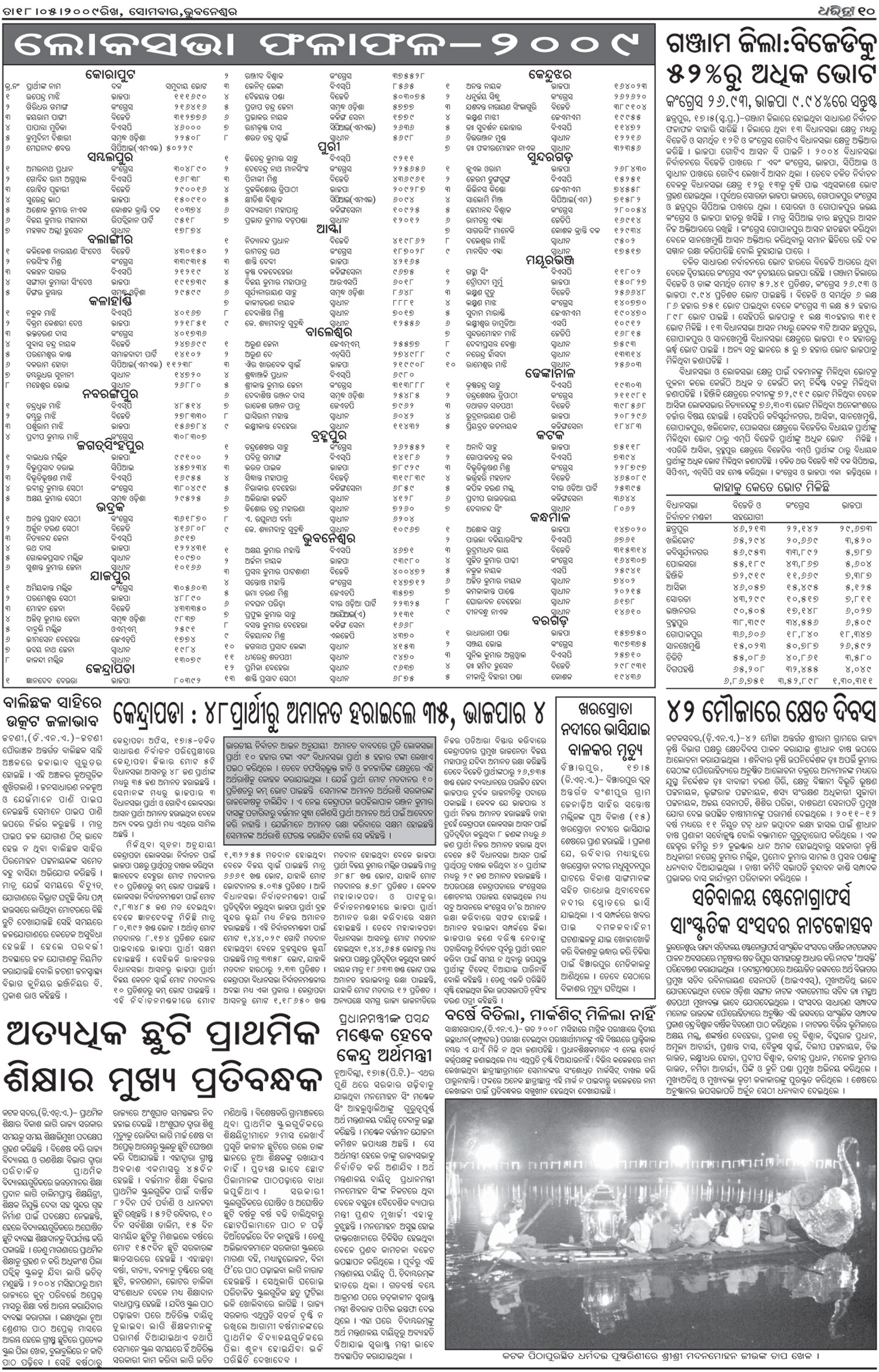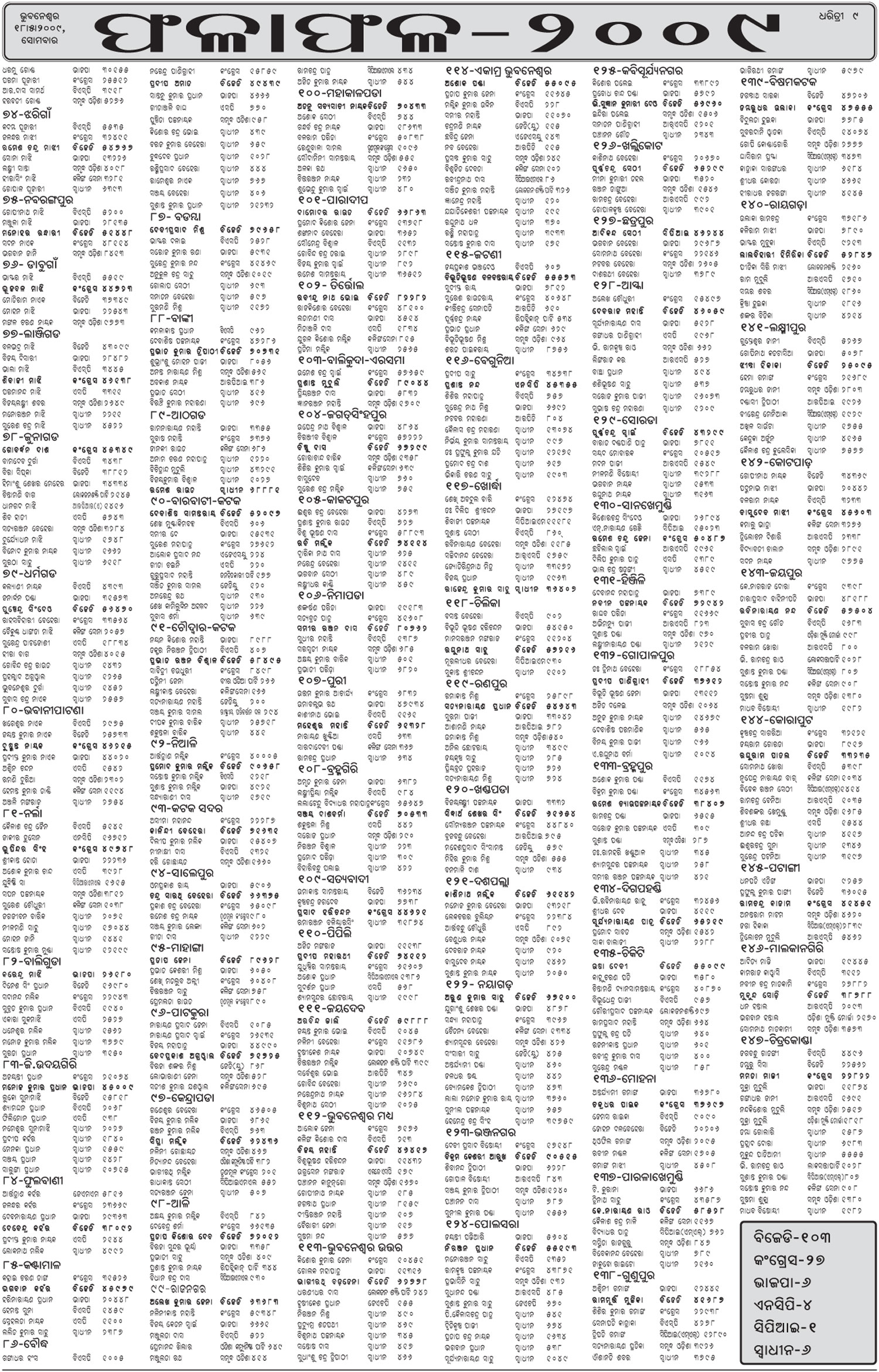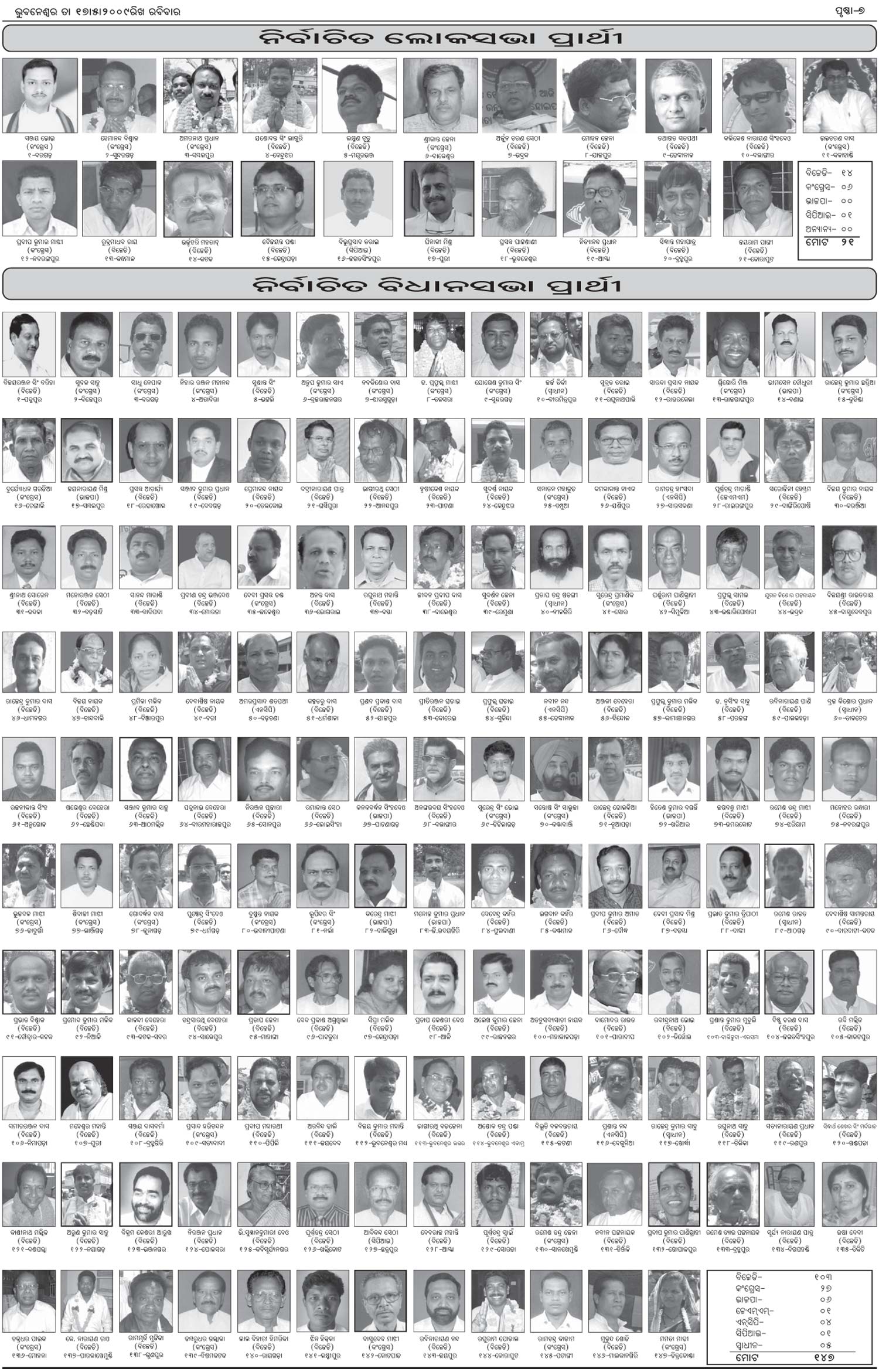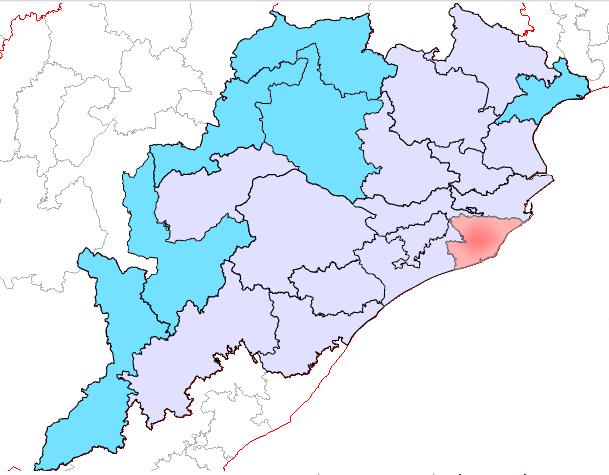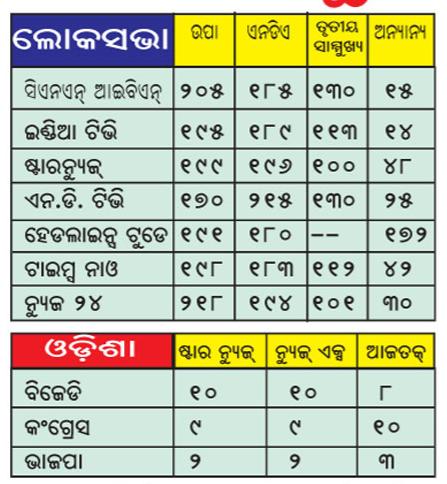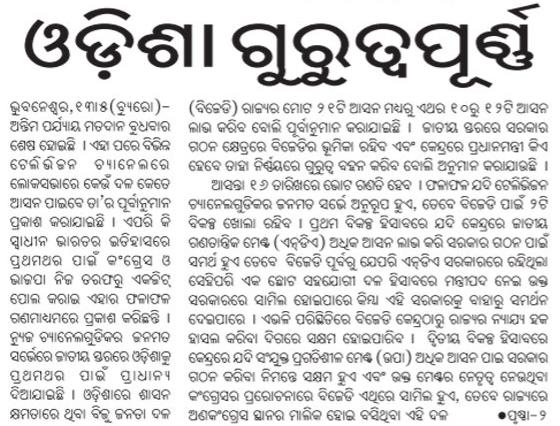Portfolio of Orissa ministers: Dharitri
Chief Minister
Naveen Patnaik: Home, General Admin., Water Resources, Works, Forest and Environment
Cabinet Ministers
Prafulla Chandra Ghadai: Finance, Excise
Damodar Rout: Agriculture, Cooperation, Fisheries and Animal Resources Development
Raghunath Mohanty: Industries, Steel and Mines, Parliamentary Affairs
A.U. Singh Deo: Planning and Coordination, Public Enterprises
Prasanna Acharya: Health and Family Welfare, Public Grievances and Pension Administration
Pramila Mallik: Women and Child Development
Debi Prasad Mishra: Higher Education, Tourism, Culture
Surjya Narayan Patro: Revenue and Disaster Management
Prafulla Samal: Panchayati Raj, Information and PR
Bijay Ranjan Singh Bariha: ST and SC Development
Bikram Keshari Arukh: Rural Development, Law
Ministers of State
Sanjib Sahoo: Commerce and Transport
Badrinarayan Patra: Housing and Urban Development
Anjali Behera: Textiles and Handloom
Pratap Jena: School and Mass Education
Atanu Sabyasachi Nayak: Energy
Sarada Prasad Nayak: Food Supplies and Consumer Welfare
Pushpendra Singhdeo: Labour and Employment
Ramesh Chandra Majhi: Information Technology, Science and Technology
Praveen Chandra Bhanja Deo: Sports & Youth Affairs, Revenue and Disaster Management
Jay Panda writes about the secret behind Naveen’s success
Following are some excerpts from that article:
The fact is that there is no secret formula. There is, instead, a clean slate, commonsensical approach to politics that would sound rational to the average citizen, but often confounds hardcore politicos. There are three key components of this new approach. First, at the core of it, is a remarkable level of sincerity and dedication. For a man who till the age of 50 spent lots of time in the rarefied social circles of New York, London and the south of France, Naveen Patnaik has not travelled abroad in more than a decade. And he rarely sees his personal home in Delhi either, only visiting the city a few times a year for official engagements. This monk-like total immersion in Orissa does not go unnoticed by the public. …
The second is a deep commitment to good governance. This goes far beyond lip service, and includes numerous instances of risky decisions. That is, risky by the standards of conventional wisdom, but which ultimately turned out to be huge political successes. In the early days, every time key cabinet colleagues were dismissed for corruption, or well-connected businessmen were arrested for criminal intimidation, there were widespread predictions that the government would fall because these actions were “naïve” and “impractical” and that “too many powerful forces were being taken on.” But instead, they resulted in sharp increases in popular support.
Gutsy decisions were taken across the board. The inefficient and corrupt lift irrigation corporation was broken up, unsettling thousands of employees, but it was replaced with the revolutionary pani panchayat system, where lakhs of villagers took responsibility for better management of water. Good governance was not all about taking on entrenched vested interests. Orissa, then broke and deeply indebted, also showed an open mind in quickly adopting the Fiscal Responsibility and Budget Management (FRBM) Act and the Value Added Tax (VAT) at a time when many states were opposing them tooth and nail.
One of the most important decisions involved taking on the government of India and the powerful mining lobby. Despite having enormous mineral reserves, Orissa had long been shortchanged by discriminatory central government policies which yielded a pittance in royalties and encouraged downstream investments to be made elsewhere. The state government’s new value addition policy linked the grant of mining leases to investments in the downstream processing plants. This has led to a huge surge of investment: more capital has flowed into Orissa in the past five years than in the previous fifty-five! The subsequent surge in state revenues has enabled many pro-poor policies.
The third component is diligent homework and a clinical, dispassionate, political decision-making process. This may sound obvious to the lay person, but is still not common in political parties. Take candidate selection, for instance. In the absence of US-style primaries, most parties even today still choose candidates by a complex process that involves intrigue, lobbying, drama, sabotage, subterranean tests of loyalty, unverifiable caste arithmetic, and even kickbacks. That often leads to sub-optimal choices. In Orissa, a quick glance at both BJP and Congress candidates reveal some breathtakingly unsuitable names who never stood a ghost of a chance.
Almost from the day the BJD was formed, and perhaps because its founder was unfamiliar with politics in the beginning, the party has relied on extensive surveys, opinion polls, exit polls, etc. These have never been devised to advertise the party’s strength, but rather to assess the ground realities and highlight weaknesses. They have always been conducted by highly rated external agencies, but quietly and only for internal party use. When it came to candidate selection, the strict criterion of winnability was applied to all, and no amount of lobbying or political clout made any difference.
Expressbuzz.com has an editorial on the topic and it has some suggestion for Naveen.
Every media outlet, print and screen, has been vying to find words to express suitable praise for Naveen Patnaik, the hat-trick winner in Orissa. He has been variously described as having a magician’s touch, an uncanny ability to read the Oriya mood, someone not beholden to the usual corrupt structure, a clean practitioner of governance and much more. We, too, acknowledge his feat, especially when so many of his more experienced counterparts have been exposed as inept players of blind man’s bluff. Having done so, however, we would like to take our readers back to a small news item we had published early this month, sent by a staffer from the city of Paradip. In summary, Patnaik had laid the foundation stone for renovation of the 82 km Cuttack-Paradip state highway in July 2007, promising completion in two years (cost: Rs 125 crore). Our staffer reported that 20 per cent of the promised work has been done, and there are gaping holes on the newly laid stretch; locals say the cracks began in the first week. Officials stonewalled queries, save the project director, who admitted to irregularities and said the thing would be redone.
And our point is simple: what exactly does this say of the state of Orissa’s administration and its accountability, after a decade of Naveen-rule? Obviously, very little has changed in the basic system. We make the point not to tar Patnaik in his moment of glory, but to bring both the man and our readers to earth, in order that this state of affairs be addressed. Changing a system single-handed is difficult enough at the best of times, but we suggest the state of a road project is an excellent place to start. Road specifications and how to achieve these are standardised; flaws show up very swiftly, and responsibility is easily pinned on whoever had the contract, the overseer and the person who approved the payment. Start enforcing the rules here and make a few examples; the system will begin reforming with urgency, without any more orders. Let each road project, in Orissa and elsewhere, display the contract’s details at 100 ft intervals, with information of where to complain. And ensure only that all complaints to state bodies are promptly registered and acknowledged, whether these come in writing or on telephone. And, weekly, put these up on a website. You’ll no longer require a hero in the chief minister’s chair; citizens will take charge.
Cuttack Municipal Corporation Contact Information (hours and locations): ad in Samaja
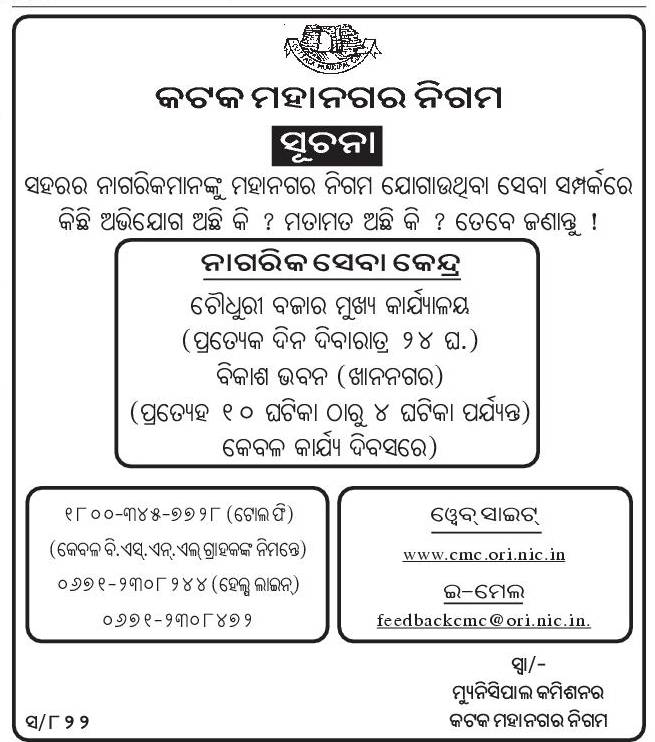
Which party received how many votes: list from Samaja

Cleaning of polluting mines in Orissa
Following is an excerpt from a report in azcentral.com about mine clean up in Arizona.
Bankrupt Tucson miner Asarco LLC has agreed to pay $30 million to clean up three contaminated mine sites in Arizona and settle the state’s longstanding environmental claims against the company.
… The property, including $4 million to improve and maintain one of Arizona’s few remaining riparian areas, compensates the state for Asarco’s contamination over the years of Mineral Creek, a tributary to the Gila River in Pinal County.
… The $1.6 billion "global settlement" would clean up some 75 sites across the country that have been polluted by Asarco over more than 100 years of active mining and smelting activity.
I wonder if Orissa government can make similar claims against those mine owners in Orissa who pollute the environment. They should start looking carefully at the Sukinda Valley and the Joda-Barbil area which rank very high among polluted places in the world.
Naveen seen as non-whimsical, a man of principle, a man who keeps his words and means what he says
Unlike leaders of many other parties such as BSP, SP, RJD, who fought against their UPA allies during the election, caused them harm, and now are extending their support to the government in Delhi, Naveen has not changed his stance of not supporting NDA or UPA. In fact if one goes back the last ten years Naveen has been fairly stable in his pronuouncments. He has not blackmailed his allies and has not flip-flopped. Thus it is a big loss for NDA and very stupid of them to have lost such a dependent ally. Naveen’s keeping-his-word personality has not gone unnoticed by the others. Hence the current UPA government is keeping its channel open with Naveen in case they may need him. Even though Naveen may not go back on his words of not supporting the UPA government, if necessary, he may abstain from voting against them, and give them issue based support. Following are some excerpts from a report in Tribune which mentions the attitude of UPA towards Naveen Patnaik.
… the Congress is also looking at Orissa chief minister Naveen Patnaik’s BJD for issue-based support as Prime Minister Manmohan Singh has personally opened channels of communication with him though Dr. Ramakanta Panda, the surgeon who operated on him earlier this year.
… As the numbers are stacked up today, the Congress has more supporters than it had bargained for with Uttar Pradesh chief minister Mayawati s BSP, which was part of the Third Front in the Lok Sabha elections, also extending unconditional outside support of its 21 MPs to the new government.
Although it is presently spoilt for choice, the Congress does not want to be overly dependent on parties like the Samajwadi Party and the BSP in view of the whimsical nature of its leaders. It would, therefore, like to be prepared for any future contingency by getting support from parties having substantial numbers.The Congress top brass has identified Nitish Kumar and Naveen Patnaik in this category.
Upgrading the Wild Animal Conservation Center in Sambalpur to a Zoo
Following are excerpts from a report in the Statesman.
The authorities of the Wild Animal Conservation Centre (WACC) popularly known as “Deer Park”, are taking a humane approach to its inmates during this scorching summer.
Deer Park is located inside Sambalpur city in a sprawling area of 35 acres, and is home to nearly 210 animals of 19 different species.
“The utmost care has been taken to supply adequate water and shelter to animals inside this centre to improve their welfare during this hot summer. Of course the green coverage inside adds to their comfort; still we have made extra arrangements for sheds inside the centre,” said Mr DK Swain – the DFO (wildlife) of Sambalpur.
… The centre now houses 94 spotted deer, 10 Chausingha, four barking deer, eight bears, five pythons, one leopard, as well as monkeys, parrots, eagles, grey horn bills and other wild birds in good numbers. And all of them are paid due attention by a well experienced ranger, Mr Amulya Kumar Parida, the DFO said.
Since the WACC is a centre of attraction for the people of Sambalpur and neighbouring districts, a proposal to improve it further has been placed before the central zoo authority, Mr Parida. “We would like to increase the number of animals, and create a beautiful garden inside to attract tourists,” the DFO said, displaying a graph showing an increase in visitors. “Our main aim is to rescue and rehabilitate animals and breed them in captivity. We wish to make this centre one-of-a-kind in the country,” he added.
The new Sambalpur MP should pursue this.
Modi’s introduction to Orissa – a spectacular failure (Thank God)
Following are excerpts from a report in Indian Express.
The JD(U) thinks the efforts of a section of the BJP to prop up Gujarat Chief Minister Narendra Modi as the future prime ministerial candidate of the NDA have contributed to the defeat of the alliance. This reaction of the JD(U) puts a question mark over Modi’s plans for the future.
Asked if the Modi issue was one of the factors which played against the NDA, JD(U) president and NDA acting convenor Sharad Yadav told reporters on Sunday that it was indeed so. He felt this caused confusion in the minds of people. “The issue should have been dismissed immediately,” he said.
Yadav had not relished the “draft-Modi-for-PM-campaign” when some BJP leaders floated the idea in the midst of the campaign. “There is no vacancy,” Yadav had said, citing the fact that senior BJP leader L K Advani had been already projected as the prime ministerial candidate.
… Contrary to the hype during the campaign, the Modi factor had failed to work to the advantage of the BJP. At the end of the day, the party has registered a gain of just one seat in his home state Gujarat. In Maharashtra, where Modi held charge, the BJP tally has actually gone down. And, notwithstanding the hectic campaign of the saffron brotherhood’s poster boy, the BJP has faced a rout in Orissa, UP, Rajasthan, Uttarakhand and Haryana, where he was touted as a star campaigner.
Orissa was supposed to be the most fertile ground for introducing Modi. The atmosphere was communally polarised in the aftermath of the Kandhamal violence and the BJP was free to return to its own agenda and ideology after breaking up with BJD. However, nothing worked.
Thank God the BJP plan for Orissa, as mentioned in the above paragraph, did not work.As we reported earlier in http://www.orissalinks.com/orissagrowth/archives/2148 and http://www.orissalinks.com/orissagrowth/archives/2133 the BJD countered Modi’s introduction to Orissa, and that plus the inherent peaceful and non-communal nature of Oriyas saved Orissa.
As the last paragraph of the quote above illustrates, there is a widespread (wrong) impression that Orissa was communally polarised.
That is not true and the proof is how BJP fared in Orissa. In Kandhamala parliamentary constituency itself the BJP candidate Ashok Sahu, who was accused and jailed for hate speech, lost. However in two assembly constituencies in Kandhamala BJP won. At best one can say that Kandhamala was communally poarised. Saying Orissa was communally polarised is as wrong as saying India was communally polarised. Outside of Kandhamala there was zero communal polarisation. PERIOD. Note that unlike Post-Godhra in 2002 or the sikh killings in 1984 the violence in Kandhamala did not spread outside of Kandhamala.
Opposition parties pursued the right approach in Kalahandi; almost.
Following are some excerpts from a news item in tathya.in.
While BJD has received an overwhelming support all over Orissa, Kalahandi district rejected the party.
The regional outfit not only lost the Kalahandi Lok Sabha seat but also the four, Junagarh, Bhawanipatna, Lanjigarh and Narla, out of five Assembly seats to the Congress party in the district.
… In 2004 General Elections to the Lok Sabha and Assembly Kalahandi district was swept by BJD and BJP combine.
However, BJD suffered serious jolt in Kalahandi on local issues.
Demand for the Central University in Kalahandi played a pivotal role in this regard, feel intelgentsia.
Self-made complications by Naveen Patnaik on this matter further made local people angry.
When the Chief Minister met a delegation from Kalahandi in May 2008 he promised that Kalahandi will get the varsity.
Mr.Patnaik promised to use his best rapport in the Ministry of Human Recourse Development to establish the Central University in Kalahandi.
The Chief Minister also asked the delegation to send land details.
Despite receiving the land details from the Collector of Kalahandi in July 2008, Orissa CM, later in August 2008 unilaterally announced to establish the Central University in Koraput.
Thus he courted controversy and wrath of the young masses of the tribal zone.
Serious protests were raised in Kalahandi.
Gauzing the public emotions in the District, Congress Committee of Kalahandi immediately made it a political issue.
The party protested to State Government and exposed it as betrayal to people of Kalahandi by the Government.
This paid high dividends to the Congress party in the district during the election by getting substantially support from educated and intellectual mass in the district.
Just two months before election, local Congress leaders’ timely attack on Kalahandi district administration while highlighting poor condition of
National Highway 201 caused by heavily loaded truck of Vedanta during mining transportation made State Government vulnerable to local public.Other local issues like poor progress of Lanjigarh Road – Junagarh railway line, poor progress of private medical college, new secondary health facilities, and failure to construct a high laying over bridge over Hati river near Junagarh since past five years made local people upset against BJD led Government.
This is an example of what I suggested in http://www.orissalinks.com/orissagrowth/archives/2227 regarding what the opposition parties in Orissa should do.
KBK Poll Graphics of various party positions
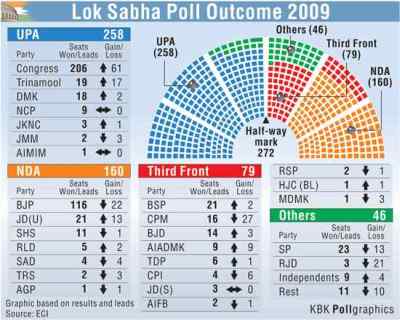
The detailed party position is as follows:
UNITED PROGRESSIVE ALLIANCE – 262
- Congress – 206
- Trinamool Congress – 19
- DMK – 18
- Nationalist Congress Party – 9
- National Conference – 3
- Jharkhand Mukti Morcha – 2
- Muslim League Kerala State Committee – 2
- All India Majlis-e-Ittehadul Muslimeen – 1
- Bodoland People’s Front – 1
- Kerala Congress (Mani) – 1
NATIONAL DEMOCRATIC ALLIANCE – 159
- Bharatiya Janata Party – 116
- Janata Dal-United – 20
- Shiv Sena – 11
- Rashtriya Lok Dal – 5
- Akali Dal – 4
- Telangana Rashtra Samithi – 2
- Asom Gana Parishad – 1
THIRD FRONT – 80
- Bahujan Samaj Party – 21
- CPI-M – 16
- Biju Janata Dal – 14
- AIADMK – 9
- Telegu Desam Party – 6
- CPI – 4
- Janata Dal-Secular – 3
- Forward Bloc – 2
- Revolutionary Socialist Party – 2
- MDMK – 1
- Haryana Janhit Congress – 1
- Jharkhand Vikas Morcha (Prajatantrik) – 1
FOURTH FRONT – 26
- Samajwadi Party – 22
- Rashtriya Janata Dal – 4
OTHERS – 15
- Independents – 9
- Assam United Democratic Front – 1
- Bahujan Vikas Aaghadi – 1
- Swabhimani Paksha – 1
- Nagaland People’s Front – 1
- Sikkim Democratic Front – 1
- VCK – 1
The Six Congress MPs from Orissa; their potential to become central ministers
The six Congress MPs from Orissa are:
- Sanjay Bhoi from Bargarh
- Hemanand Biswal from Sundergarh (he defeated Jual Oram)
- Amarnath Pradhan from Sambalpur (he defeated Rohit Pujari)
- Srikant Jena from Balasore
- Bhakta Das from Kalahandi
- Pradeep Majhi from Nabarangpur
Sanjay Bhoi is considered a young leader. Hemanad Biswal is a tribal and was CM of Orissa before and the fact that he defeated a BJP national level official further increases his stature. Amarnath Pradhan has been a minster in Orissa. His nomination forced Rohit Pujari to quit Congress and join BJD and run against him. Srikant Jena has been a cabinet minister in the center. Bhakta Das has been a state minister in the center. I don’t know much about Pradeep Majhi. (Update: There is a profile article on Pradeep Majhi in http://www.breakingnewsonline.net/2009/05/youth-power-indian-youth-congress.html. and another one in http://news4u.co.in/?p=9577. He is 32 years old and a youth Congress leader.)
Based on the above, one (or hopefully both) of Hemanand Biswal and Srikant Jena may become a cabinet minister in Delhi. Bhakta Das has a good chance of becoming a minister in Delhi.
Orissa shows to BJP that it does not buy its agenda
The best of this election with respect to Orissa is that it has made BJP to be an inconsequential party in Orissa. In 2009 BJP has less assembly seats (6) from Orissa than it had parliament seats (7) in 2004 and it has ZERO parliament seats from Orissa in 2009. I hope BJP learns the lesson that people of Orissa do not fall for BJP’s agendas, they like peace and they were horrified by the happenings in Kandhamala and the ensuing bad name Orissa got worldwide. BJP showed its true colors by picking people like Ashok Sahu as its MP candidate from Kandhamala and Manoj Pradhan (who is accused of violence in Kandhamal and is currently in jail) as its MLA candidate from G. Udaygiri. Unfortunately Manoj Pradhan won in G. Udaygiri. But fortunately the total tally of BJP in Orissa is SIX.
Now many BJP leaders are creating the spin that they have not done that bad nationally; and its just that Congress took over many of the third front seats. Although that is kind of true, it would be a mistake for BJP to not learn the lesson that at the India level there are fewer takers of its agenda and image. In this I agree with Swapan Dasgupta in this article in Pioneer. Following are some excerpts.
There is a facile explanation that many of those who neither anticipated nor wished for a Congress victory in the general election may fall back on. It goes something like this: the Congress and UPA surge was contributed by its spectacular successes in Kerala, West Bengal, Andhra Pradesh and Tamil Nadu where its principal opponent was either the Left or another constituent of the ramshackle Third Front. The implication is that the NDA by and large held its ground.
Such an explanation would be an exercise in complete self-delusion. …
In the coming days, debate in the BJP is certain to centre on the question: what went wrong? Such a debate is not only necessary but welcome. Unfortunately, past experience suggests that the discussions often veer in the direction of the peripherals. There will be hand-wringing over the “internal sabotage” in Madhya Pradesh and Uttarakhand; speculation over why Om Prakash Chauthala rather than Bhajan Lal was chosen as the coalition partner in Haryana; mutterings over whimsical choice of candidates in some seats of Uttar Pradesh; and the inevitable back-biting over the campaign in the mass media.
It is not that these concerns are unwarranted. However, presuming that everything had turned out perfectly, the BJP and NDA would, at best, have improved its tally only marginally by, say, 15 seats. It wouldn’t have made any material difference to the outcome. Voters, it must be remembered, aren’t automatically swayed by the same concerns as activists.
In undertaking a post-mortem, it is important to not lose sight of the big picture. The BJP and NDA lost because voters found the Congress a more appealing prospect. …
What was not neutralised was the overall image problem of the BJP—as a party that is backward-looking, too shrill and insufficiently attentive to contemporary concerns.
Arguably, such a regressive image of the party may be a consequence of media-generated “false consciousness”. But the fact remains that this perception has percolated down to a very large section of the population. And the BJP has done precious little to counter it.
In the wake of defeat, there is always a strong temptation to retreat into a back-to-the-basics shell. This is based on the foolish belief that people didn’t vote for a party because it wasn’t sufficiently pure. The belief is as ridiculous as the suggestion that the Soviet Union fell because it wasn’t adequately socialist! …
At the national level, image has come back to haunt the party—a problem compounded by leaders who believe it is more important to please activists rather than be responsive to ground realities.
I agree with most of the above analysis. If BJP needs to survive and do well it must desist from always pleasing its activists, disassociate itself from hate speeches (like the one allegedly given by Varun Gandhi), hate activities (like the ones in Kandhamala, post-Godhra, and to some ecxtent in Karnataka) and correct some of the wrongs that it has been associated with. If that means dumping some of its star leaders associated (rightly or wrongly) with this hate , that needs to be done. Where perception is important, hiding behind legalieties and smart-aleck statements like "If I have done what people are accusing me of, put me in jail" won’t cut it. People of India are not that stupid. They can see through such statements. (BJP should learn from Congress’s performance in Delhi and Punjab which is being partly attributed to its dropping tainted Jagdish Tytler and Sajjan Kumar from MP candidacy.)
Thus if BJP doesn’t do some housecleaning starting with cutting ties with activists who preach hate as well as leaders who are associated with hate, they will also keep losing more allies – Nitish Kumar’s party is expected to be the next, and will keep moving away from power nationally.
I came across a blog entry by Dilip D’Souza. I agree with one of the comments there. It says:
Dilip is right. Centre Right is wide open and it is for BJP’s taking. It has proven credentials on this side. It can move into this house straightaway. All it needs to do is to jettison Modi, Varun etc. It should reduce Hindutva to the level of fighting appeasement politics. It will get its day in the sun.
Many of the comments mentioned in B. Raman’s article at http://election.rediff.com/column/2009/may/17/loksabhapoll-shock-and-awe-on-pro-hindutva-web-sites.htm also make a lot of sense. Following is a sample.
1. ‘I think BJP should dismantle, and regroup under a new name, new leadership, with a bit more conviction (I mean the mental kind, not legal) and spine. Bottom line: The BJP does not impress Hindus any more, and it manages to frighten non-Hindus. Not a combination to win India.’
4. … I am seriously disappointed by the disastrous performance of BJP.’
… You also don’t want ultra patriots among you who might do serious damage to your battle plan. It is almost like giving the enemy your ammo stock even while you are running low yourself. Varun Gandhi [Images] played that spoiler. He may have made a tactical error in judgement but the moment the national and international media caught that it brought about strategic implication. Sadly, the BJP’s reaction was hew and haw without clear and concise action/reaction.’
‘Remember how George W Bush [Images] disowned Trent Lott? That is what leadership is. Does not matter how charismatic a person is and how popular he/she might be but the moment he/she steps out of line, he/she however capable must be gone. In 1991 the deputy commander of all US forces arrayed against Iraq made a statement to the press about how the war would be waged. Norman Schwarzkopf fired him even though he was said to be a brilliant war planner because he went to the press without approval. Despite being friendly with the Bush family he was fired nevertheless.’
…’Beating up couples on Valentine dates or trashing pubs/nightclubs will alienate these folks. The Hindu forces should be geared to fight Taliban [Images]isation and not become like the Taliban. Believe it or not, of all the good things you do one small infraction is all that is needed for the media to show you like a demon. The zealots played into the hands of the media like fools. For a youngster in Chennai who has heard of BJP and other Hindu right movements, he would know little of what great work these movements are doing in Gujarat or Haryana. But he would hear from the media when a couple on a Valentine date get beaten up. That would be his impression of the Hindutva movement.’
‘Like the old saying: A drop of ink is enough to spoil a bucket of milk.
… Then the alienation and division among Hindus. Given that Hindus are intrinsically secular, stealth must have been the operative word. You cannot charge around like a bull. People however worried about their Hindu religion will be seriously repulsed. You should win the heart and mind of people via stealth instead of repulsing them.’
‘Does the BJP stand for all Hindus or some Hindus only? If a man does not do his husbandly duties, his wife will not sit and wait around. She is bound to seek the arms of another willing man. And there is no shortage of men who will not think twice of doing the deed when a vulnerable or willing housewife arrives on the scene. This is the same with the controversy surrounding conversion. Why do people convert to another religion? Can we all agree that the reason they convert is because the new religion offered them hope and other related benefits that the original religion did not offer? You can cry till your lungs burst about the activities of the evangelists but as long as you have a vulnerable population that you hardly care except that they convert to another religion. The ants will keep moving to where the sugar is. It’s the law of nature that you cannot change. Until Hindus themselves take the initiative to empower and help the downtrodden and vulnerable among them, these same vulnerable and downtrodden will be played for their votebanks by the cunning foxes.’
…”On the whole all these news about goondas beating up people, colour TV or sack of rice or money in exchange for vote stinks big time.
Some excerpts from http://offstumped.nationalinterest.in/2009/05/16/india-elections-2009-congress-humbles-bjp/ and comments there in.
4. Riots have consequences we can no longer be in denial on VHP’s conduct. There has to be accountability for the riot in Orissa.
10. Last but not the least, it would be in complete denial if it did not ask tough questions of how Acts of Adharma in the name of Hindutva have been condoned and the relevance of Hindutva as an ideology to guide on Socio-Economic issues.
I strongly believe they have support on issues like minority appeasement and they are capable of creating a strong development platform. But the image BJP has created for itself, that of an extremist party, has alienated voters who would otherwise agree with them on many issues.
1. Ditch the RSS, Bajrang Dal etc : Imposing your idea of Hindutva and Hindu culture on the diverse Hindu population of India is NEVER going to work. It will only serve to shrink your Hindu base. Focus on issues, issues, issues – not people’s nightlife.
2. Ditch Modi : I am afraid the BJP is going to take up Modi as a leader and seal its own fate. This would be a huge mistake. They need a young moderate face. As one commentator pointed out – image is everything. I would not even call the Congress a political party – i think they are family business whose sole purpose is to perpetuate dynastic rule. But the image on the surface is suave enough to fool people.
3. Keep with the internal party democracy : I think this is what makes BJP a credible political party and wins it respect. If anything they need to strengthen it and consciously groom more leaders.
4. Strengthen the moderate voices and talk ISSUES from a principled perspective. Talk about true secularism and what it means, take about an inclusive India but one that does not compromise on its principles to appease minorities. Talk about development and your vision. Take the higher road. Mainstream Hindus want BJP to fight these issues through legislative means, not on the streets like a bunch of goons. Means have always been important to the Indian people. BJP needs to rise, elevate the dialogue and earn respect. It is possible to raise these issues without being jingoistic.
I am praying that the BJP is able to transform itself into a right-of-center party. Its voice is sorely needed on the Indian political landscape.
… a great observation – why DID the blame for Ram Sene stick to BJP? Very simple: if you don’t protect your brand then your competition will smear it and destroy it. Did the BJP do anything to counter that positioning of blame? Mere statements of disassociation with SRS from RSS or BJP are not enough, they need to launch solid campaigns and ensure that their message overwhelms the competing message. How can I counter the ladies in my family who voted against the BJP saying that “BJP is so communal – their people beat up women in Mangalore!! Chhi, chhi – so horrible they are!”. Logic doesn’t work, boss – that image has been formed and reinforced 1000 times with every possible outlet from the mainstream media, or even by hundreds of blogs.
Look, it’s a dirty game – one of the oldest tricks in marketing is for you to define the competitor’s position if they haven’t done it themselves. For years and years, BJP has been defined and confined to a small space defined by attributes such as “violent” and “communal” by the Congress while claiming the “secular” and “progressive” space for itself. It’s a huge disadvantage to the BJP because in the battle for converting a Congress voter to the BJP, BJP is forced to be either on the defensive (if the target is an educated secular voter) or go to the other extreme and actually go further into the “communal” positioning (if the target is a communally polarised voter) like Varun Gandhi did. This is not a winnable strategy! BJP cannot deliver the brand promise to either of these segments, and will eventually lose them.
Comparing 2009 and 2004 election results; Orissa’s position
| BJD | Congress | BJP | Others | |
| 2004 Assembly | 61 | 38 | 32 | IND 8, JMM 4, OGP 2, CPI 1, CPM 1 |
| 2009 Assembly | 103 | 27 | 6 | NCP 4, CPM 2, CPI 1, Others 4 |
| 2004 Lok Sabha | 11 | 2 | 7 | JMM 1 |
| 2009 Lok Sabha | 14 | 6 | 0 |
CPI 1 |
The following map shows which part won which Lok Sabha constituency in Orissa. (It is from http://164.100.9.52/ge2009/Final.html.) The blue is where Congress won, the grey is where BJD won and the red is where CPI won.
Compared to 2004, Orissa is better of in 2009 with respect to its leverage with the center.
- In 2004 it had only 2 MPs from the ruling party, this time it has 6. I hope that leads to more ministers from Orissa, including one cabinet minister and one state minister.
- In 2004 BJD with its 11 MPs was part of NDA and BJD was dependent on BJP support in the state to get majority; so the ruling party in the center could just ignore BJD MPs of Orissa as it had no hope of getting their support. In 2009 BJD has 14 MPs. Although BJD has said it will not support UPA, the UPA may still harbor hope that in a crunch it may need BJD and so it would not completely ignore BJD.
- However, the fact that UPA has very good numbers in 2009, and NDA and Left have done bad, UPA does not desperately need BJD support or abstention. Thus BJD does not have that much bargaining power to demand some special goodies for Orissa in return for its support or abstention.
- This win increases the stature of Naveen Patnaik further and he will be taken more seriously in Delhi.
- Jay Panda, having become a Lok Sabha MP, will also have a higher stature now.
Early results look good for Orissa’s interest
May 16 2009 12:54 AM Arizona Time (1:24 PM India):
Earlier in http://www.orissalinks.com/orissagrowth/archives/2036 I had suggested that a BJD MP contingent of 15+ MPs will be the best for Orissa. Later in http://www.orissalinks.com/orissagrowth/archives/2196 taking into account Naveen Patnaik’s statement that he would not support Congress, I revised my opinion and sugested that 12-13 BJD MPs and 8-9 Congress MPs would be good for Orissa.
4:26 AM AZ/4:56 PM India: From http://www.eciresults.nic.in/StateWiseTrends.htm. (Leading- BJD: 14, CPI:1, Congress:6)
|
Orissa |
1 |
Bargarh |
Sanjay Bhoi |
Indian National Congress |
Dr. Hamid Hussain |
Biju Janata Dal |
65555 |
NO |
|
Orissa |
2 |
Sundargarh |
Hemanand Biswal |
Indian National Congress |
Jual Oram |
Bharatiya Janata Party |
874 |
NO |
|
Orissa |
3 |
Sambalpur |
Amarnath Pradhan |
Indian National Congress |
Rohit Pujari |
Biju Janata Dal |
26167 |
NO |
|
Orissa |
4 |
Keonjhar |
Yashbant Narayan Singh Laguri |
Biju Janata Dal |
Dhanurjaya Sidu |
Indian National Congress |
90756 |
NO |
|
Orissa |
5 |
Mayurbhanj |
Laxman Tudu |
Biju Janata Dal |
Sudam Marndi |
Jharkhand Mukti Morcha |
40188 |
NO |
|
Orissa |
6 |
Balasore |
Srikant Kumar Jena |
Indian National Congress |
Arun Dey |
Nationalist Congress Party |
23101 |
NO |
|
Orissa |
7 |
Bhadrak |
Arjun Charan Sethi |
Biju Janata Dal |
Ananta Prasad Sethi |
Indian National Congress |
47839 |
NO |
|
Orissa |
8 |
Jajpur |
Mohan Jena |
Biju Janata Dal |
Amiya Kanta Mallik |
Indian National Congress |
72645 |
NO |
|
Orissa |
9 |
Dhenkanal |
Tathagata Satpathy |
Biju Janata Dal |
Chandra Sekhar Tripathi |
Indian National Congress |
174224 |
NO |
|
Orissa |
10 |
Bolangir |
Kalikesh Narayan Singh Deo |
Biju Janata Dal |
Narasingha Mishra |
Indian National Congress |
56159 |
NO |
|
Orissa |
11 |
Kalahandi |
Bhakta Charan Das |
Indian National Congress |
Subash Chandra Nayak |
Biju Janata Dal |
104528 |
NO |
|
Orissa |
12 |
Nabarangpur |
Pradeep Kumar Majhi |
Indian National Congress |
Domburu Majhi |
Biju Janata Dal |
28479 |
NO |
|
Orissa |
13 |
Kandhamal |
Rudramadhab Ray |
Biju Janata Dal |
Suzit Kumar Padhi |
Indian National Congress |
124183 |
NO |
|
Orissa |
14 |
Cuttack |
Bhartruhari Mahtab |
Biju Janata Dal |
Bibhuti Bhusan Mishra |
Indian National Congress |
187505 |
NO |
|
Orissa |
15 |
Kendrapara |
Baijayant Panda |
Biju Janata Dal |
Ranjib Biswal |
Indian National Congress |
45581 |
NO |
|
Orissa |
16 |
Jagatsinghpur |
Bibhu Prasad Tarai |
Communist Party of India |
Rabindra Kumar Sethy |
Indian National Congress |
74469 |
NO |
|
Orissa |
17 |
Puri |
Pinaki Misra |
Biju Janata Dal |
Braja Kishore Tripathy |
Bharatiya Janata Party |
178674 |
NO |
|
Orissa |
18 |
Bhubaneswar |
Prasanna Kumar Patasani |
Biju Janata Dal |
Santosh Mohanty |
Indian National Congress |
198294 |
NO |
|
Orissa |
19 |
Aska |
Nityananda Pradhan |
Biju Janata Dal |
Ramachandra Rath |
Indian National Congress |
147206 |
NO |
|
Orissa |
20 |
Berhampur |
Sidhant Mohapatra |
Biju Janata Dal |
Chandra Sekhar Sahu |
Indian National Congress |
44360 |
NO |
|
Orissa |
21 |
Koraput |
Jayaram Pangi |
Biju Janata Dal |
Giridhar Gamang |
Indian National Congress |
82915 |
NO |
More exit polls; Dharitri says that BJD would be in a good bargaining position for Orissa
I kind of agree with the above analysis that BJD can put Orissa in a good bargaining position. In addition if there is a UPA government in center with 7+ Congress MPs there could be a cabinet minister and a state minister from Orissa; hopefully in ministries where they can be of help.
Times Now Exit Poll Lok Sabha projections for Orissa: Congress 9, BJD 8, BJP 4
My prediction: Congress 7, BJD 12, BJP 2.
The Times Now projection for the rest of the country is as follows:
| Congress | BJP | Other UPA | Other NDA | Others | |
| India | 154 | 142 | 44 | 41 |
Left – 38 Others – 124 |
| Orissa | 9 | 4 | BJD – 8 | ||
| Kerala | 12 | 3 | Left – 5 | ||
| Tamil Nadu | 4 | DMK 7 |
Left – 4 AIADMK – 24 |
||
| West Bengal | 5 | TM Congress – 12 | Left – 24 | ||
| Uttar Pradesh | 13 | 17 |
BSP – 28 SP – 23 |
||
| Maharashtra | 12 | 13 | NCP – 11 | Shiv Sena – 12 | |
| Karnataka | 9 | 16 | JDS – 3 | ||
| Rajasthan | 13 | 10 | 2 | ||
| Gujarat | 7 | 19 | |||
| Madhya Pradesh | 6 | 23 | |||
| Andhra Pradesh | 15 | TDP 15, TRS 5, PRP 4, Left 2, Others 5 | |||
| Assam | 5 | 4 | AGP – 3 | BPF – 1, AUDF – 1 | |
| Bihar | 3 | 10 | RJD LJP – 6 | JDU – 19 | Left – 1, Others – 1 |
| Chhatisgarh | |||||
| Jharkhand | |||||
| Punjab | |||||
| Haryana | |||||
| Himachal Pradesh | |||||
| J & K | |||||
| Delhi | |||||
| Goa | |||||
IOC ties up funding for its Rs 29,777 crores refinery in Paradeep
Following is from a report in Hindu.
Indian Oil Corporation has tied up finances for its Rs 29,777 crore Paradip refinery project in Orissa that would be commissioned by March 2012.
"We have received commitments from a consortia of banks," IOC Chairman Sarthak Behuria said.
SBI Caps, which was mandated to arrange Rs 14,700 crore debt for the project, has managed Rs 14,900 crore from 21 banks. State Bank of India (SBI) will be the largest lender with Rs 4,200 crore exposure.
IOC was likely to sign loan agreements with the consortia of banks on May 14.
"We will draw (from these loans) as and when we need them," he said but did not give details.
IOC is targeting commissioning of the refinery in first quarter of 2012. The board had recently split the refinery cum petrochemical complex into two, deciding to do the refinery first and the chemical unit will follow later.
Paradip refinery is being configured to process the toughest, heaviest and the most dirtiest crudes which are cheaper than the cleaner and easier varieties. The refinery will have a Nelson Complexity Index of 15.

